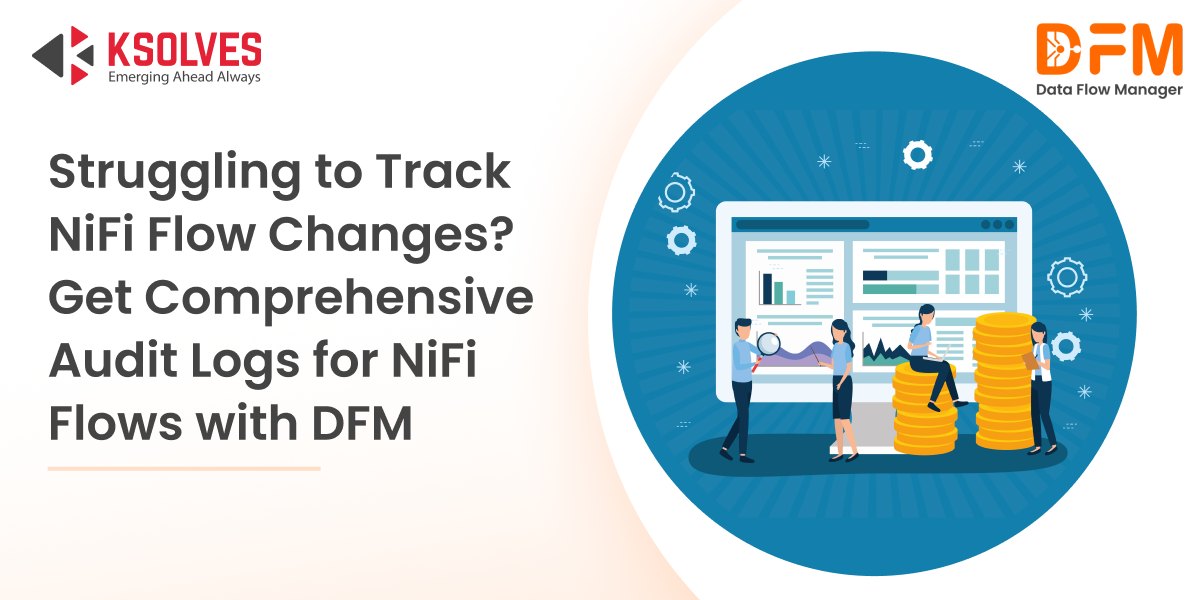The Hidden Complexity of Auditing NiFi Flow Changes, and How to Eliminate It
![]()

In high-stakes data environments, change is constant, but visibility into those changes is often lacking. As NiFi flows evolve across development, QA, and production, most teams struggle to answer a basic question: who changed what, when, and where?
For organizations bound by regulations like GDPR, HIPAA, or SOX, the inability to track flow modifications can lead to more than operational setbacks. It introduces compliance risk, slows down incident resolution, and erodes confidence in your data pipelines.
Yet, despite its strengths, Apache NiFi offers limited tools for auditing flow changes out of the box. That’s where the hidden complexity lies, and why it’s time to rethink how your team manages NiFi governance at scale.
The Audit Challenge in NiFi-Powered Pipelines
At its core, Apache NiFi provides excellent data provenance tracking. You can see where data comes from and how it moves across processors. But when it comes to auditing the operational lifecycle of the flow itself – deployments, updates, promotions, or rollbacks – the capabilities are minimal.
Some of the most common audit-related gaps in NiFi environments include:
- No native logs of user-level actions on flows: There’s no consolidated view of who deployed or modified a flow and when.
- Lack of visibility into cross-environment promotions: Moving a flow from Dev to QA to Prod is often done manually, with no consistent record of what changed between environments.
- No historical change tracking: Once a flow is updated, its previous state is often lost unless teams use the NiFi Registry correctly and diligently.
- No centralized dashboard for audits: Compliance and operations teams lack a single source of truth to verify change history during internal or external reviews.
These limitations are not merely technical; they introduce compliance risk, operational blind spots, and avoidable inefficiencies.
Why Manual Audit Logging for NiFi Flows Doesn’t Scale
To compensate for NiFi’s lack of built-in change auditability, many organizations resort to manual logging practices. This often includes:
- Engineers documenting changes in shared spreadsheets.
- Flow versions stored as XML templates in local folders.
- Deployment activities communicated through Slack or email.
- Occasional Git backups without structured version tagging.
These stopgap solutions might work temporarily in small teams—but they collapse under the weight of scale, complexity, and compliance expectations.
Read More: – Common NiFi Challenges Every Team Faces and How DFM Solves Them
The risks of manual audit tracking include:
- Inconsistency: Not everyone follows the same logging process.
- Human error: Manual entries are often forgotten or misrecorded.
- Lack of traceability: You can’t easily recreate what changed and why.
- No real-time insight: Audit information is always retrospective, not proactive.
When an auditor or stakeholder asks, “Who promoted this change to production last Tuesday?”, you shouldn’t need to dig through chat logs or spreadsheets for the answer.
The Stakes: Compliance, Debugging & Team Accountability
The consequences of poor auditability reach far beyond compliance. In fast-moving data environments, auditable change control is the backbone of trust – the trust in your systems, your team, and your data itself.
Without it, you risk:
- Regulatory non-compliance: Regulations like GDPR, HIPAA, and SOX require clear change histories and access logs for systems handling sensitive data.
- Incident resolution delays: When something breaks in production, it’s crucial to quickly identify recent changes and who made them.
- Environment drift: Without controlled promotion paths, inconsistencies between Dev, QA, and Prod can lead to unexpected behavior.
- Team friction: Without visibility into flow changes, teams may struggle with accountability and coordination.
Audits are no longer just for compliance; they’re critical for operational excellence.
What Audit-Ready NiFi Flow Management Should Look Like
An audit-ready NiFi deployment doesn’t rely on memory or manual work. It’s systematic, transparent, and automated.
Here’s what a modern, compliant approach to NiFi flow change management should offer:
- User-level change tracking: Every change to a flow is tagged with the user ID, timestamp, and description.
- Deployment history: A full timeline of when flows were deployed or promoted across environments.
- Environment-specific context: Ability to differentiate changes made in Dev, QA, or Prod.
- Version comparison: Easy visibility into what changed between flow versions or environments.
- Centralized dashboard: A single pane of glass for change logs, audit history, and deployment activity.
NiFi doesn’t provide these capabilities natively, but they are essential for organizations that prioritize governance and compliance.
Introducing Data Flow Manager: Auditability for NiFi Flows by Default
This is precisely where Data Flow Manager (DFM) bridges the gap.
Data Flow Manager is designed to eliminate the manual overhead and risk involved in auditing NiFi flow changes. It integrates seamlessly into your existing NiFi setup and introduces structured, automated governance over your flow promotion and deployment processes.
With Data Flow Manager, you get:
- Automatic change tracking: Every flow deployment, promotion, or rollback is logged with user identity, timestamp, and version history.
- Environment-aware deployment: Manage and monitor flow movement from development to staging to production, all with traceability.
- Audit-ready exports: Generate reports of change history for compliance reviews, internal audits, or incident investigations.
- Centralized visibility: Access a unified view of all flow activities across teams and clusters.
By integrating audit logging into the deployment pipeline itself, DFM enables data teams to focus on innovation without sacrificing accountability.
Read More:- Apache NiFi for Data Enrichment: Build Powerful Data Pipelines for Enhanced Insights
Conclusion
Auditing changes to NiFi flows is not just a compliance checkbox; it’s a foundation for reliable, resilient, and secure data operations. In today’s regulatory landscape and fast-paced development cycles, manual audit tracking is a risk no team can afford.
The solution is not more documentation. It’s smarter automation.
With Data Flow Manager, organizations can take the guesswork out of governance, ensuring that every flow change is logged, traceable, and audit-ready by design.
![]()

